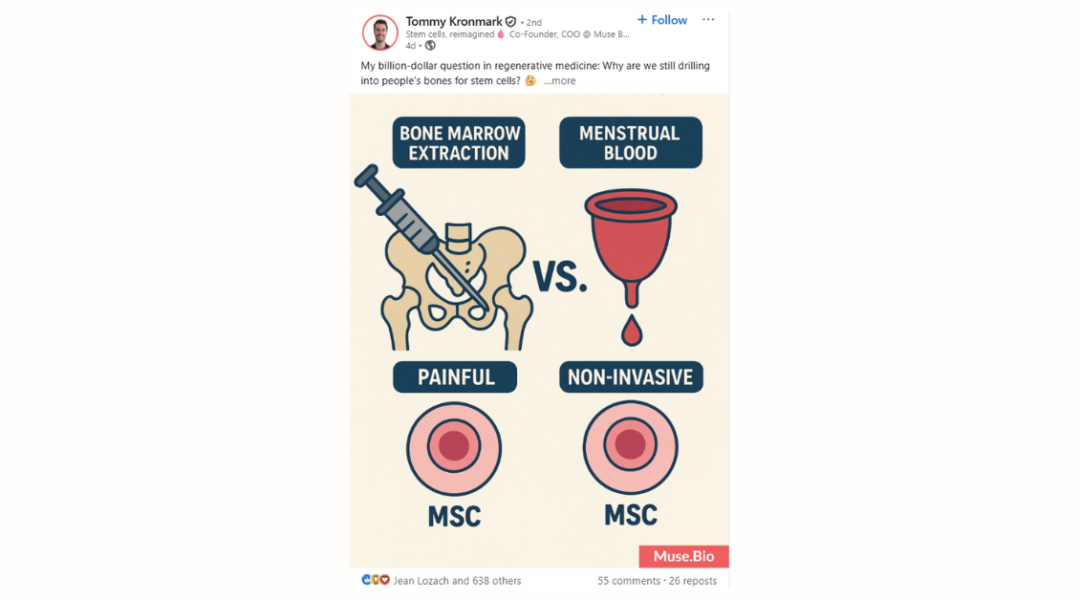AI for Medical Illustrations: When Bold Beats Boring in Healthcare Communication
Building on our insights about why biotech companies should use visual storytelling, let’s examine a controversial tool that’s changing the game: AI-generated medical illustrations.
Introduction: The Great AI Debate in Medical Visualization
“AI shouldn’t be used for science illustrations.”
I hear this statement almost daily in my work creating biotech animations. Moreover, in principle, I agree. Medical illustrations should be accurate. However, here’s the thing that many people miss: it depends on context.
Recently, when Tommy Kronmark from muse.bio shared an AI-generated image comparing bone marrow extraction to menstrual blood stem cell collection, it stopped me cold. Not because it was anatomically perfect – it wasn’t. Instead, it succeeded because those bold red cells against a white background made me stop scrolling immediately.
As a result, I realized something important: sometimes, in medical communication, bold beats boring.
The Context Conundrum: Where AI Medical Illustrations Shine
Social Media vs. Medical Textbooks
First and foremost, context matters enormously when using AI for medical illustrations. The standards for a LinkedIn post are fundamentally different from those for a medical textbook or peer-reviewed publication.
Where AI works well:
- Social media posts designed to spark curiosity
- Educational content for general audiences
- Patient education materials (with proper review)
- Awareness campaigns
- Initial concept visualization
Where traditional illustration is essential:
- Medical textbooks
- Peer-reviewed publications
- Clinical training materials
- Surgical guides
- Diagnostic references
Why Bold Colors and Simple Visuals Win on Social Media
The Science of Scroll-Stopping
In our world of 3-second attention spans, medical communicators face a unique challenge: how do you make complex science accessible without dumbing it down? The answer often lies in pattern disruption – creating visuals unexpected enough to stop the scroll.
AI-generated illustrations excel at:
- Bold color contrasts that demand attention
- Simplified representations that convey concepts quickly
- Visual metaphors that make abstract ideas concrete
- Emotional resonance through accessible imagery
The Power of Imperfection
The slightly “cartoonish” quality of AI-generated medical images can be an advantage on social media. It signals that the image is simplified for understanding rather than a clinical reference – managing expectations while still delivering educational value.
Best Practices for Using AI in Medical Illustrations
1. Start with Clear Intent
Ask yourself:
- What’s my primary goal? (Awareness, education, engagement?)
- Who’s my audience? (Patients, students, general public?)
- Where will this be displayed? (Social media, website, presentation?)
2. Embrace the AI Look (But Make It Better)
- Use AI for concept generation
- Rework images in Photoshop or editing tools
- Add accurate labels and annotations manually
- Combine AI elements with traditional graphics
3. Quality Control is Non-Negotiable
- Fact-check all visuals
- Avoid misleading anatomical relationships
- Get medical review when possible
- Add disclaimers when needed
4. Avoid the Uncanny Valley
- Don’t over-process images to look “too perfect”
- Maintain stylistic consistency
- Use AI as a starting point, not the final product
- Consider hybrid approaches
Time and Cost Benefits: The Practical Reality
AI saves significant time and money. For many healthcare organizations, the choice isn’t between AI and professional medical illustration – it’s between AI and no images at all.
Benefits include:
- Generate concepts in minutes vs. days
- Cost-effective for testing multiple ideas
- Accessible to smaller organizations
- Enables rapid iteration and refinement
- Democratizes visual science communication
The Future of AI in Medical Animation and Illustration
At Life Science Animation, we don’t yet use AI for our professional animations, but we increasingly use it for:
- Concept development
- Storyboard creation
- Visual reference gathering
- Testing color schemes and compositions
- Generating background elements
This hybrid approach combines the efficiency of AI with the precision of professional illustrators.
Ethical Considerations and Transparency
Being Honest About AI Use
- Disclose AI involvement when relevant
- Credit AI tools and human creators
- Clarify educational vs. clinical purpose
- Maintain ethical representation
Avoiding Misinformation
- Never present AI illustrations as clinical references
- Avoid misleading visuals of medical procedures
- Ensure cultural sensitivity
- Consider patient understanding and anxiety
Practical Tips for Healthcare Communicators
Getting Started with AI Medical Illustrations
- Choose the right tools
- Develop a prompt library
- Create a review process
- Build a style guide
- Invest in post-processing skills
Common Pitfalls to Avoid
- Over-relying on AI
- Ignoring audience health literacy
- Forgetting accessibility (e.g., colorblind users)
- Neglecting context
Conclusion: Bold Beats Boring, Every Time
The debate about AI in medical illustration isn’t about whether we should use it – it’s about when and how.
On social media, where attention is currency, a bold, slightly imperfect AI image that makes people stop and think beats a technically perfect illustration that nobody notices.
Different contexts demand different approaches. A LinkedIn post about stem cell alternatives doesn’t need textbook-level accuracy – it needs to spark curiosity and conversation.
Use AI boldly. Be clear about your purpose. Always put your audience first.
Final Note from Life Science Animation
At Life Science Animation, we believe in using the right tool for the right job. Our professional animations maintain the highest standards of scientific accuracy, but effective science communication sometimes means choosing impact over perfection.
📩 Contact us to learn how we can help you find the perfect balance for your medical communication needs.

